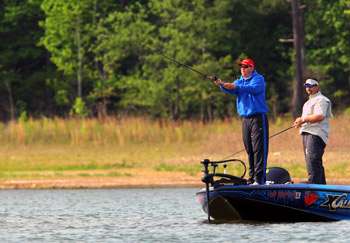
Name
Alton Jones
Hometown
Waco, Texas
Technique
Stickworms are dense, cigar-shaped soft plastic baits that can be fished in a wide variety of ways. Because they are heavier than most other soft plastics, they sink faster, and their shapes usually create a seductive wiggle as they fall. Since they cast well and sink fast, many anglers use them as alternatives to weighted plastic worms.
History
Stickworms were invented by Gary Yamamoto in the 1990s. His first stickworm was dubbed the "Senko," and he created it while trying to develop a new soft plastic jerkbait using heavily salted plastic. The shape of the bait (and most stickworms since that time) was inspired by a ball point pen.
Highlights
Jones first began using stickworms before the 2003 Bassmaster Tour season and began winning with them almost immediately. He won the 2003 Tour event on California's Clear Lake using a Yum Dinger. More recently, Jones used a Dinger to win the St. Johns River Showdown in 2012, his first Elite Series victory.
When to Use
Jones uses stickworms year-round, but has the most success whenever the fish are shallow, especially in the spring. He claims there are few better big fish baits.
Where to Use
Jones says any cover in water that is less than 5 feet deep is worth fishing with a stickworm. In the spring, he will target spawning pockets (holes) in dense cover or spawning coves. If there is brush, a stump or other isolated cover, Jones will toss his stickworm right next to it.
Tackle
While he has several setups for stickworms, the one Jones uses the most is a 7-foot medium-heavy Kistler Z-Bone casting rod mated to an Ardent Edge Elite reel spooled with 50-pound-test braid connected via a double Uni-knot to 20-pound-test Gamma fluorocarbon as a leader. He says braid is needed to make long casts and set the hook when lots of line is out.
Lure
Yum's 5- and 6-inch Dingers get most of the work, but Jones says that different waters call for different stickworms. On Falcon Lake, for example, Jones may use the 6-inch model, while he'll typically throw a 3-incher at Lake Erie. He prefers green pumpkin with purple flake, watermelon or watermelon red flake.
Basics
Jones says long casts and the bait's splash are key in stickworm fishing. He likens the technique to flipping and pitching, but from greater distances. He says the splash is not an issue since your boat is far from the fish. Without a boat nearby, he believes a splash means food to a fish. Once Jones has found shallow cover he is satisfied with, he will cast to it, let the worm sink, take up the slack with the reel and then determines if a fish has it or not. If not, he'll let it sit for five or six seconds, then reel it back to the boat. Jones will not work it all the way back to the boat because most hits come on the fall, and in the time it takes him to work it back to the boat, he could have made more casts, thus covering water more effectively. If Jones feels weight on the line after the cast, he will further tighten the line then give the rod a firm sweep to the side. The tension on the line and the stretch-free braid negates the need for a jarring hook set.
One More Thing
The most common error that Jones sees anglers make is over-working the worm. "The way these worms are made, they have the action built right into them. They have a very subtle shake when they fall — almost like an injured baitfish — and this is where nearly all the hits occur. You'd be better served making more casts to more cover instead of working it during the retrieve."
Originally published March 2011




